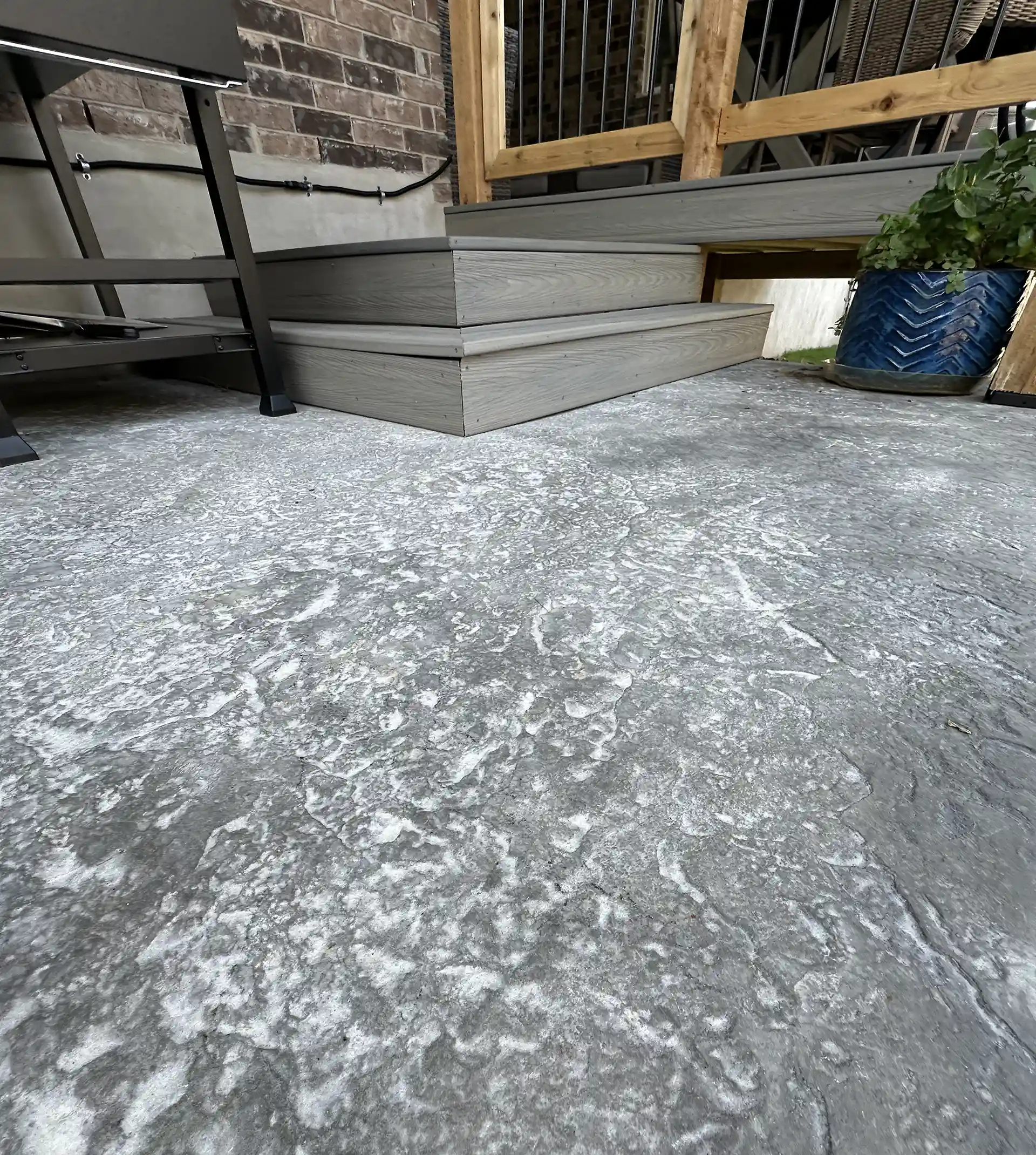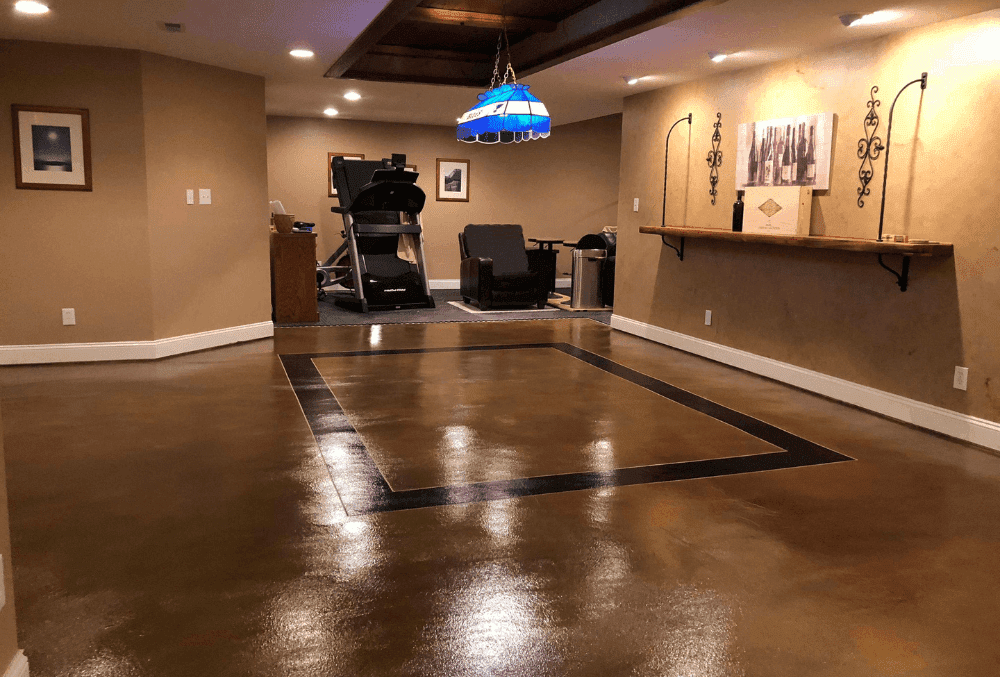Why stained concrete austin is the cost-effective flooring solution
Recognizing the Different Kinds of Stained Concrete for Your Next Task
Stained concrete offers various alternatives that accommodate different visual and useful demands. Each kind offers distinct attributes that influence the last look and toughness of the surface area. Understanding these distinctions is essential for any person planning a task. From rich, chemical responses of acid-based stains to the dynamic harmony of solid shade stains, the selections can significantly influence the outcome. What variables should one think about when picking the optimal tarnish for their specific demands?
Introduction of Stained Concrete
Stained concrete works as a functional floor covering option that can improve the visual allure of various areas. This technique includes using a tinting agent to the surface of existing concrete, enabling a wide spectrum of style opportunities. Stained concrete is preferred in both residential and commercial atmospheres, using a durable and low-maintenance option that can resemble the look of all-natural products like stone or tile.
The staining process can be implemented using water-based or solvent-based items, each giving distinctive visual effects. The final appearance is influenced by elements such as the original concrete surface, the sort of tarnish made use of, and the application approach. Stained concrete not just improves exterior and interiors yet additionally advertises sustainability by renewing existing concrete frameworks. Therefore, it has acquired grip among house owners and developers seeking both performance and style in their flooring selections.
Acid-Based Stains: Features and Advantages

Unique Color Variants
Concrete surface areas can change dramatically with the application of acid-based stains, which provide a rich combination of one-of-a-kind shade variations. These stains penetrate the concrete, reacting chemically to produce dynamic earth tones that range from deep browns and reds to soft eco-friendlies and blues. The resulting colors are usually variegated, creating an all-natural, marble-like look that boosts the concrete's personality. Each application returns distinctive results due to variants in the concrete's composition and the discoloration strategy made use of, making every task one-of-a-kind. Furthermore, acid-based stains can be layered or combined with other techniques to create tailored layouts, permitting individual expression. This adaptability makes acid-based stains a prominent option for both domestic and commercial applications.
Chain Reaction Explained
While many factors add to the performance of acid-based stains, the underlying chemical responses play a vital function in their unique characteristics and benefits. These stains largely consist of water, acid, and metallic salts. When related to concrete, the acid responds with the calcium hydroxide in the cement, creating a chemical change that results in long-term shade changes. The metallic salts permeate the surface area and bond with the concrete, permitting a vast array of colors and tones. This reaction not only boosts aesthetic allure however also supplies toughness, making the shade immune to fading and wear. Additionally, acid-based stains can develop a variegated surface that resembles natural rock, additional improving their appeal for ornamental concrete applications.
Surface Preparation Importance
Accomplishing ideal outcomes with acid-based stains hinges on thorough surface prep work. This vital action guarantees that the concrete surface area is tidy, devoid of pollutants, and effectively profiled for optimal tarnish absorption. Any existing sealants, dust, or oils can hinder the chain reaction that generates the wanted color and surface, bring about uneven or irregular outcomes.
Before using the tarnish, the concrete should be mechanically cleaned up or stress cleaned, adhered to by a complete assessment for splits or imperfections that may need repair service. In addition, confirming the surface is adequately dried will improve discolor adherence. By focusing on these primary actions, the long life and vibrancy of acid-based stains can be considerably boosted, resulting in a more aesthetically pleasing and resilient finish.
Water-Based Stains: Functions and Advantages

Water-based stains permeate the concrete, providing an extra translucent surface that highlights the all-natural texture and variants of the surface below. They are available in a wide variety of shades, permitting for innovative flexibility in style. Furthermore, water-based stains are less complicated to tidy up, needing only water and soap, which simplifies the application process.
Their fast drying out time enhances efficiency, making them a functional option for both DIY fanatics and experts. On the whole, water-based stains offer an appealing mix of aesthetic flexibility and easy to use properties, making them a popular choice for concrete enhancement jobs.
Strong Shade Stains: Vivid Options for a Bold Look
Solid shade stains offer an efficient remedy for those looking for to develop a vibrant and vivid visual on concrete surface areas. These stains supply a consistent pigmentation that can drastically improve the visual appeal of floors, patios, and driveways. Available in a vast range of tones, strong color stains enable imaginative expression, satisfying different design preferences.
One of the key benefits of strong color stains is their ability to hide blemishes, providing a fresh and sleek seek to maturing concrete - visit this page Stained Concrete Floors Austin Tx. Additionally, their solution commonly consists of UV-resistant residential properties, making sure durability and color retention also in extreme weather problems
Application is simple, requiring very little preparation of the concrete surface. When applied, strong color stains can be secured for added protection and sheen, more raising their aesthetic high quality. With their vibrant alternatives, solid shade stains are an exceptional option for those going for an impactful and natural style.
Semi-Transparent Stains: Attaining Depth and Measurement
Semi-transparent stains supply an one-of-a-kind method to boosting concrete surfaces by providing depth and measurement with various color choices. Understanding the application methods is important for attaining the desired impact, while proper upkeep practices ensure longevity. This section will certainly explore these essential facets to take full advantage of the advantages of semi-transparent staining.
Shade Options Available
A wide range of shade alternatives exists for semi-transparent stains, enabling house owners and developers to improve the all-natural beauty of concrete surfaces. These stains can be found in a selection of shades, from earthy tones like browns and terracottas to lively shades such as blues and greens. The semi-transparent nature of these stains enables the underlying concrete to reveal via, creating a distinct depth and measurement that can enhance numerous design looks. In addition, incorporating different colors can produce customized shades, allowing a customized seek each task. This adaptability makes semi-transparent stains a popular choice for both interior and exterior applications, as they can harmonize with surrounding elements while adding visual rate of interest to ordinary concrete.
Application Methods Described
To accomplish the preferred depth and dimension with semi-transparent stains, appropriate application methods are necessary. Initially, surface preparation is crucial; the concrete should be clean and devoid of any contaminants. This frequently involves power washing and fixing any type of fractures. Next, picking the ideal applicator, such as a sprayer, roller, or brush, can influence the final look. Sprayers enable a much more even application, while rollers can help attain structure. It is necessary to apply the tarnish in slim, even layers, permitting each layer to dry prior to including one more. Manipulating the application technique, such as differing pressure or using various tools, can create one-of-a-kind impacts. Securing the stained surface enhances the vibrancy of the shades while offering protection.
Upkeep Ideal Practices
Routine upkeep is vital for preserving the appeal and integrity of surface areas treated with semi-transparent stains. To maintain these surfaces, regular cleansing is important. Making use of a pH-neutral cleaner and a soft-bristle broom will help eliminate dust and debris without damaging the tarnish. It is suggested to prevent extreme chemicals, as they can degrade the discolor's appearance. In addition, regular resealing every from this source one to 3 years can secure against wear and fading. This process entails cleaning the surface completely and using a suitable sealant developed for stained concrete. Home page owners ought to additionally keep track of for any type of indicators of staining or damages and address these issues quickly to ensure resilient vibrancy and resilience. Adhering to these ideal practices will enhance the general life expectancy of semi-transparent stained surface areas.
Impacts and Strategies: Tailoring Your Stained Concrete
Customizing stained concrete involves an array of techniques that enhance both appearances and capability. Amongst these approaches, layering various tarnish shades can develop deepness and intricacy, enabling for special aesthetic impacts. Methods such as acid staining give a variegated look, while water-based stains supply an extra consistent appearance.
Furthermore, integrating ornamental patterns, such as stenciling or inscription, can better individualize the surface area, adding elaborate designs that accommodate specific preferences. Texturing the concrete, whether with stamping or broom finishes, presents tactile elements that not just boost hold but likewise enhance aesthetic rate of interest.
Applying sealants can magnify the color vibrancy and provide defense against wear. Customization strategies extend past plain color; they can change a typical concrete piece into a magnificent focal point, making it suitable for both residential and commercial rooms. Through mindful option of impacts and techniques, stained concrete can attain a genuinely tailored appearance.
Upkeep and Durability of Stained Surfaces
Stained concrete surface areas are known for their resilience and visual charm, keeping their integrity is necessary for guaranteeing durability. Regular cleaning is crucial; sweeping and wiping with a pH-neutral cleaner aids avoid dirt build-up and staining. Furthermore, using a sealer every few years can secure the surface area from moisture, chemicals, and UV damage, therefore enhancing its life expectancy.
It is additionally important to attend to any cracks or chips immediately. Tiny repairs can reduce additional damage, preserving the visual and architectural quality of the surface. For outside stained concrete, seasonal maintenance, such as getting rid of snow and ice, is necessary to stop surface area damages from freeze-thaw cycles.
Often Asked Questions
Can I Discolor Existing Concrete Surfaces or New Ones?
The question of whether existing concrete surface areas can be stained occurs frequently. It is indeed feasible to tarnish both new and old concrete, offered the surface is adequately ready and devoid of impurities for suitable bond.
How Lengthy Does the Discoloration Process Typically Take?
The discoloration process typically takes one to 3 days, relying on elements such as surface prep work, type of tarnish, and climate condition. Stained Concrete Austin. Curing time might prolong past preliminary application, influencing the general duration significantly
Is Stained Concrete Safe for Outdoor Use?
Stained concrete is normally secure for exterior use, provided it is appropriately sealed. This securing protects against dampness and UV damages, making sure sturdiness and safety and security, while likewise boosting the aesthetic charm of outdoor areas.
Can I Use Multiple Discoloration Layers for Different Impacts?
Using multiple tarnish layers can attain varied impacts on stained concrete. It is crucial to assure compatibility between stains and permit proper drying time in between applications to prevent unplanned reactions or discoloration.
Exist Any Kind Of Shade Limitations for Stained Concrete?
Color limitations for stained concrete mainly rely on the type of discolor utilized, with water-based stains supplying a broader palette compared to acid-based stains. Austin Stained Concrete Floors. However, achieving dynamic colors might need cautious option and application strategies